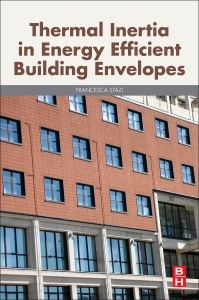Description
Thermal Inertia in Energy Efficient Building Envelopes
Author: Stazi Francesca
Language: English
Subjects for Thermal Inertia in Energy Efficient Building Envelopes:
Keywords
Building envelope; Chimney effect; Chimney height; Clay masonry; Cross-laminated timber; Decrement factor; Durability of thermal insulation; Dynamic envelope solutions; EN ISO 137862007; Energy analyses; Energy saving; Envelope conservation state; Environmental impact; Environmental sustainability; Existing envelope retrofit; Existing insulation; Experimental study; Experimentation on ventilated wall; External insulation layer; Global cost of retrofit interventions; Global costs; Heat transfer across the envelope; Indoor comfort level assessment; Internal areal heat capacity; Lightweight envelopes; Limits for heat capacity; Mass and climate; Massive load-bearing envelopes; Multidisciplinary method; Numerical simulations; Occupant's behavior; On-site evaluation of building envelope; Opaque cladding; Optimal envelope; Optimal retrofit solution; Optimization of new envelopes; Passive systems; Periodic analysis method; Periodic thermal transmittance; Platform frame technique; Selection of wall layers; Sol-air temperature; Solar wall; Solid brick masonry; Thermal bridges; Thermal comfort; Thermal inertia; Thermal overheating; Time shift; Traditional wall constructions; Trombe wall; Unfilled cavity wall; Ventilated facades; Ventilated insulation layer; Ventilation; Virtual model calibration; Wood-cement
Support: Print on demand
Description
/li>Contents
/li>Readership
/li>Biography
/li>Comment
/li>
The design and construction of the appropriate building envelope is one of the most effective ways for improving a building?s thermal performance.Thermal Inertia in Energy Efficient Building Envelopes provides the optimal solutions, tools and methods for designing the energy efficient envelopes that will reduce energy consumption and achieve thermal comfort and low environmental impact.
Thermal Inertia in Energy Efficient Building Envelopes provides experimental data, technical solutions and methods for quantifying energy consumption and comfort levels, also considering dynamic strategies such as thermal inertia and natural ventilation. Several type of envelopes and their optimal solutions are covered, including retrofit of existing envelopes, new solutions, passive systems such as ventilated facades and solar walls. The discussion also considers various climates (mild or extreme) and seasons, building typology, mode of use of the internal environment, heating profiles and cross-ventilation
Civil Engineers, Mechanical engineers, Architects, Construction Project Managers, Building service and energy control engineers, Energy auditors and managers, and Environmental Engineers.
- Experimental investigations on real case studies, to explore in detail the behaviour of different envelopes
- Laboratory tests on existing insulation to quantify the actual performances
- Analytical simulations in dynamic conditions to extend the boundary conditions to other climates and usage profiles and to consider alternative insulation strategies
- Evaluation of solutions sustainability through the quantification of environmental and economic impacts with LCA analysis; including global cost comparison between the different scenarios
- Integrated evaluations between various aspects such as comfort, energy saving, and sustainability




